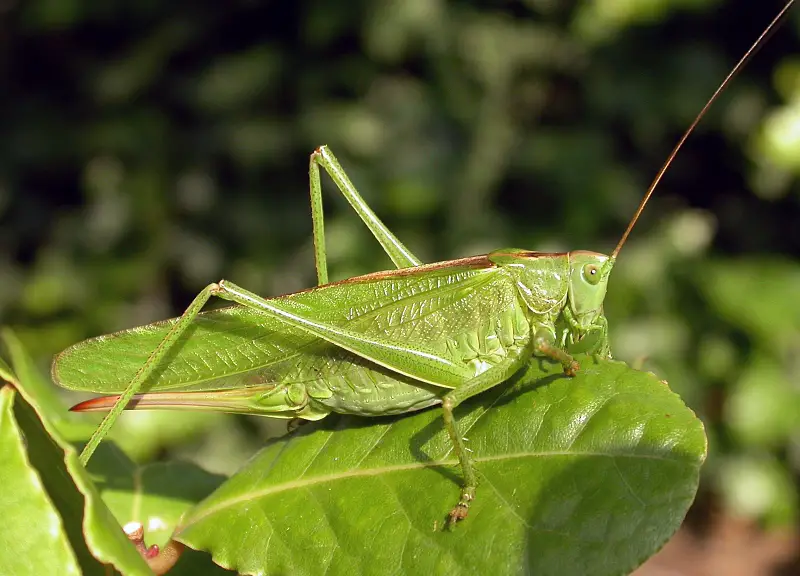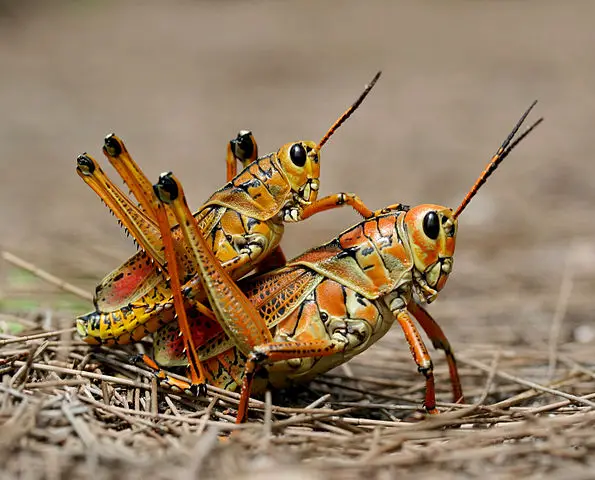The grasshopper is an insect that hatches from an egg into a nymph and will shed its skin many times before becoming a fully-grown adult. It doesn’t have a pupa stage. These insects live everywhere around the world except in areas of extreme cold like the north and south poles.
As an insect, the grasshopper has 6 legs, a head, thorax, and abdomen. It has an exoskeleton (hard covering) to protect its insides. It has 2 antennae. They have 2 pairs of wings attached to the thorax; the back wings are large and the front wings are hard and small. They have chewing mouthparts like their relatives – the katydid and the cricket.

The two rear legs are extraordinarily large so they can jump up to 20 times their body length. The hind legs act like catapults – they bend their legs at the knee and seem to relax and then they leap into the air like a released spring. As well, while they are airborne, they can use their wings to fly to escape predators.
Another defence that grasshoppers have is that they can spit a brown liquid to discourage a predator from eating them. It seems that some predators find this disgusting and will leave it alone.
It is estimated that there are 11,000 species of grasshopper. They can be almost any color – brown, yellow, reddish-brown, green, greenish-brown, and even striped. They are often colored according to their habitat in order to camouflage themselves to hide from predators, such as birds, spiders, lizards, and beetles.
Some male grasshoppers have bright colors on their wings which they flash in mid-jump to attract the female. Some grasshoppers eat poisonous plants and keep the toxins in their bodies. This turns their bodies a bright color to warn predators that they have a terrible taste.
Grasshoppers are herbivores. That is, they eat leaves of plants, grasses, and cereal crops. When they swarm, especially locusts, they can consume a farmer’s entire crop. In just the United States, they cause more than $1 billion in damage to crops and grasslands every year.
Grasshoppers are similar to locusts and crickets. While grasshoppers and locusts are herbivores, crickets are omnivores, meaning they eat other bugs as well as plants.
Grasshoppers have shorter antennae than crickets. Both grasshoppers and locusts make a chirping sound by rubbing a hind leg against a forewing, much like a violin bow against a violin string and it is the wing that vibrates or sings. Crickets chirp by rubbing their wings together. Grasshoppers and locusts are active during the day and crickets are nocturnal.

Grasshoppers ‘hear’ with their abdomen. Under the wings are membranes that vibrate when sound waves hit them. This is the simplest type of eardrum called a tympana. They sense or feel other insect sounds and other grasshoppers rather than hear them. Crickets ‘listen’ with their legs.
Many people eat grasshoppers as they are an excellent source of protein. People in remote areas in Africa, Central America, and South America eat insects, including grasshoppers because they don’t have access to other sources of meat.

Questions:
- What are the stages of development of a grasshopper?
- Name the body parts of a grasshopper.
- What are the defences the grasshopper uses as protection against predators?
- How does a grasshopper make its chirping sound?
- Grasshoppers are herbivores; what does this mean?
Answers:
- The stages of development of a grasshopper are: egg, nymph, and adult.
- The grasshopper has a head, thorax, abdomen, 2 sets of wings, 6 legs, and 2 antennae.
- The grasshopper’s defences are camouflaging color, rear legs that can propel it 20 times its length, wings that allow it to fly, and a brown spit that is repellent.
- The grasshopper makes a chirping sound by rubbing it hind leg against the forewing.
- The grasshopper is an herbivore – it eats vegetation.